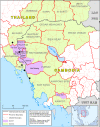Respondent-driven sampling on the Thailand-Cambodia border. I. Can malaria cases be contained in mobile migrant workers?
- PMID: 21554744
- PMCID: PMC3116496
- DOI: 10.1186/1475-2875-10-120
Respondent-driven sampling on the Thailand-Cambodia border. I. Can malaria cases be contained in mobile migrant workers?
Abstract
Background: Reliable information on mobility patterns of migrants is a crucial part of the strategy to contain the spread of artemisinin-resistant malaria parasites in South-East Asia, and may also be helpful to efforts to address other public health problems for migrants and members of host communities. In order to limit the spread of malarial drug resistance, the malaria prevention and control programme will need to devise strategies to reach cross-border and mobile migrant populations.
Methodology: The Respondent-driven sampling (RDS) method was used to survey migrant workers from Cambodia and Myanmar, both registered and undocumented, in three Thai provinces on the Thailand-Cambodia border in close proximity to areas with documented artemisinin-resistant malaria parasites. 1,719 participants (828 Cambodian and 891 Myanmar migrants) were recruited. Subpopulations of migrant workers were analysed using the Thailand Ministry of Health classification based on length of residence in Thailand of greater than six months (long-term, or M1) or less than six months (short-term, or M2). Key information collected on the structured questionnaire included patterns of mobility and migration, demographic characteristics, treatment-seeking behaviours, and knowledge, perceptions, and practices about malaria.
Results: Workers from Cambodia came from provinces across Cambodia, and 22% of Cambodian M1 and 72% of Cambodian M2 migrants had been in Cambodia in the last three months. Less than 6% returned with a frequency of greater than once per month. Of migrants from Cambodia, 32% of M1 and 68% of M2 were planning to return, and named provinces across Cambodia as their likely next destinations. Most workers from Myanmar came from Mon state (86%), had never returned to Myanmar (85%), and only 4% stated plans to return.
Conclusion: Information on migratory patterns of migrants from Myanmar and Cambodia along the malaria endemic Thailand-Cambodian border within the artemisinin resistance containment zone will help target health interventions, including treatment follow-up and surveillance.
Figures
References
-
- Zhou G, Sirichaisinthop J, Sattabongkot J, Jones J, Bjonstad ON, Yan G, Cui L. Spatio-temporal distribution of Plasmodium falciparum and P.vivax malaria in Thailand. Am J Trop Med Hyg. 2005;72:256–262. - PubMed
-
- Containment of artemisinin resistance and moving towards the elimination of Plasmodium falciparum in Thailand. 2010. CCM-Thailand Round 10 malaria proposal to the GFATM.
-
- Confirmation, characterization and containment of artemisinin resistance in South East Asia. A 2-year Bill and Melinda Gates-funded and WHO-led project. The Bill and Melinda Gates Foundation and the World Health Organization; http://www.gatesfoundation.org/Grants-2008/Pages/World-Health-Organizati...
-
- Delacollette C, D'Souza C, Christophel E, Thimasarn K, Abdur R, Bell D, Dai TC, Gopinath D, Lu S, Mendoza R, Ortega L, Rastogi R, Tantinimitkul C, Ehrenberg J. Malaria trends and challenges in the Greater Mekong subregion. Southeast Asian J Trop Med Public Health. 2009;40:674–691. - PubMed
-
- Containment of malaria multi-drug resistance on the Cambodia-Thailand border. Report of an informal consultation. World Health Organization; 2007. http://whothailand.healthrepository.org/handle/123456789/792
Publication types
MeSH terms
LinkOut - more resources
Full Text Sources



